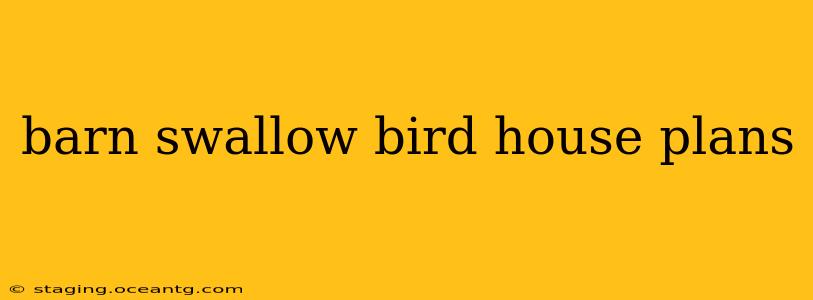Barn swallows, with their graceful flight and acrobatic feeding maneuvers, are a delight to watch. Attracting these beautiful birds to your property can enhance your garden's biodiversity and provide hours of enjoyable birdwatching. Building a barn swallow birdhouse is a rewarding project, offering a safe and welcoming nesting site for these aerial acrobats. However, unlike other bird species, barn swallows have very specific needs when it comes to their nesting habitat. This guide will walk you through creating the perfect barn swallow house, addressing common questions along the way.
What Makes a Good Barn Swallow Birdhouse?
Unlike cavity-nesting birds, barn swallows don't nest inside enclosed boxes. They prefer open, sheltered locations to build their mud nests. Therefore, a "barn swallow birdhouse" isn't a traditional box but rather a structure providing protection from the elements and predators. Key features include:
- Open-fronted design: The structure needs an open front, allowing easy access for the birds to enter and exit. Avoid enclosed boxes.
- Sheltered location: Position the structure under an overhang, eave, or porch to shield it from rain and direct sunlight.
- Secure mounting: Ensure the structure is securely mounted to prevent it from falling or swaying in the wind.
- Mud-friendly surface: The surface material should be rough enough for the swallows to adhere their mud nests. Untreated wood is ideal.
- Predator protection: The design should deter predators like cats, snakes, or raccoons from accessing the nests. Consider adding a small lip or ledge to prevent smaller predators from reaching the nests.
What Materials Do I Need to Build a Barn Swallow Birdhouse?
The beauty of building a barn swallow shelter is that it doesn't require complex or expensive materials. You can use readily available items, such as:
- Untreated wood: Use untreated lumber, preferably pine or cedar, for its durability and resistance to rot.
- Nails or screws: Galvanized nails or screws are best for outdoor use to prevent rust.
- Wire or strong string: To secure the structure to its mounting point.
- Optional: Metal flashing or roofing felt: To further protect the structure from the elements.
How Do I Build a Barn Swallow Birdhouse?
While precise plans vary, here's a general approach:
- Design: Sketch your design. Keep it simple – a basic L-shaped structure with an open front is sufficient.
- Cut the wood: Cut the lumber according to your design. Remember to account for the thickness of the wood when calculating dimensions.
- Assemble the structure: Assemble the pieces using nails or screws. Ensure the structure is sturdy and level.
- Mounting: Securely mount the structure under an overhang or eave using wire or strong string. The height should be at least 6-8 feet off the ground.
- Optional additions: Add a small lip or ledge to the front to help prevent smaller predators from reaching the nests. Consider using metal flashing or roofing felt to improve weather protection.
What Size Should My Barn Swallow Birdhouse Be?
The dimensions are less critical than the overall design for barn swallows. The important factor is providing a sheltered and open area, approximately 10-12 inches wide and 8-10 inches deep. The depth isn't as crucial as the sheltered area beneath the overhang, which is the birds' primary need.
Where Should I Place My Barn Swallow Birdhouse?
Placement is key. Barn swallows prefer to nest near open areas like fields, meadows, or water sources, where they can easily forage for insects. The structure should be positioned under a protected area, such as an overhang or eave, at a height of at least 6-8 feet from the ground. Avoid placing it in direct sunlight or exposed to strong winds.
What if Barn Swallows Don't Use My Birdhouse?
Even with the perfect birdhouse, barn swallows may not always choose to nest in it. Their nesting site selection depends on several factors, including habitat availability, predator pressure, and the presence of suitable nesting materials (mud). If they don't use it the first year, don't be discouraged. Maintain the structure and try again next year. Providing a reliable source of water nearby can also increase their likelihood of nesting on your property.
Conclusion
Building a barn swallow birdhouse is a simple yet rewarding project. By following these guidelines and providing a suitable location, you significantly increase the chances of attracting these elegant birds to your garden. Remember, patience is key; even if they don't use the house immediately, it provides a valuable contribution to their habitat and may attract them in the future. Enjoy the process and the beautiful spectacle of barn swallows nesting nearby!
